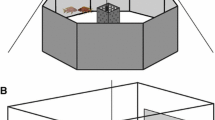Abstract
A 2 yr. old captive sea lion (Zalophus californianus) presented with a discrimination task permitting little visibility of the targets gradually increased the frequency with which it made a series of underwater clicks. Further tests revealed that the amount of clicking elicited was inversely related to the degree of visibility and that the animal was incapable of discriminating between inanimate targets of different size and sound-reflecting characteristics on the basis of active sonar alone.
Similar content being viewed by others
References
ANDREW, R. J. 1964. Vocalization in chicks and the concept of “stimulus contrast.” Animal Behav., 7, 64–76.
BERLYNE, D. E. 1960. Conflict, arousal, and curiosity. New York: McGraw-Hill.
BROUGHTON, W. B. 1964. Method in bio-acoustic terminology. In R. G. Busnel (Ed.) Acoustic behaviour of animals. Amsterdam: Elsevier.
EVANS, W. E. & HAUGEN, R. 1963. An experimental study of the echo-location ability of a California sea lion, Zalophus californianus (Lesson). Bull. S. Calif. Acad. Sci., 62, 165–175.
GRIFFIN, D. R. 1958. Listening in the dark. New Haven: Yale Univ. Press.
KELLOGG, W. N. 1961. Porpoises and sonar. Chicago: Univ. Chicago Press.
NORRIS, K. S., PRESCOTT, J. H., ASA-DORIAN, P. V., & PERKINS, P. 1961. An experimental demonstration of echo-location behavior in the porpoise, Tursiops truncatus. Biol. Bull., 120, 163–176.
PARVULESCU, A. 1964. Problems of propogation and processing. In W. N. Tavolga (Ed.) Marine bio-acoustics. New York: Pergamon.
POULTER, T. C. 1963. Sonar signals of the sea lion. Science, 139, 753–755. (a)
POULTER, T. C. 1963. The sonar of the sea lion. Inst. Elec. Electron. Eng. Trans., 10, 109–111. (b)
ROBINSON, J. & GANTT, W. H. 1947. The orienting reflex (questioning reaction): cardiac, respiratory, salivary and motor components. Johns-Hopkins Hospital Bull., 80, 321–353.
SCHEVILL, W. E., WATKINS, W. A. & RAY, C. 1963. Underwater sounds of pinnipeds. Science, 141, 50–53.
SCHUSTERMAN, R. J., KELLOGG, W. N. & RICE, C. E. 1965. Underwater visual discrimination bv the California sea lion. Science, 147, 1594–1596.
SCHUSTERMAN, R. J. & FEINSTEIN, S. H. 1965. Shaping and discriminative Control of underwater click vocalizations in a California sea lion. Science, 150, 1743–1744.
Author information
Authors and Affiliations
Additional information
This research was supported by NSF Grant GB-1437 and was presented at the 1965 meetings of the Eastern Psychological Association, Atlantic City, N J.
A click has been defined as a discrete sound pulse of short duration (see Broughton, 1964).
Rights and permissions
About this article
Cite this article
Schusterman, R.J. Underwater Click Vocalizations by a California Sea Lion: Effects of Visibility. Psychol Rec 16, 129–136 (1966). https://doi.org/10.1007/BF03393651
Published:
Issue Date:
DOI: https://doi.org/10.1007/BF03393651




